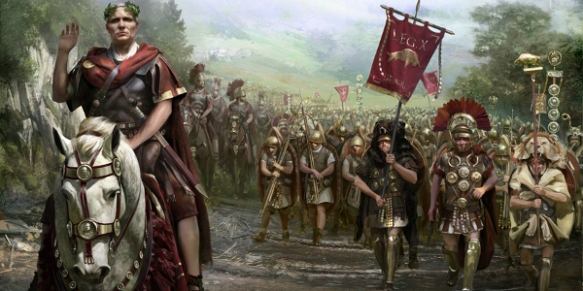A few weeks after his great victory over the Helvetii, Caesar learned of a new, pressing danger. This time it was German tribesmen, led by a king named Ariovistus.
The Germanic tribesmen were distantly related to the Gauls, but there the comparison ended. The Germans were known for being much fiercer and more warlike than the Gauls, and recent incursions into Gaul had shown the Germans how fertile the soil there was. Ariovistus was one of a number of Germanic leaders who claimed the right to sections on the west bank of the Rhine River; now he made his move.
Ordinarily the Gauls would have fought the Germans on their own. Many Gallic leaders, especially their Druidic priests, told the people that if they relied on the Romans, they would end up with a new set of invaders and conquerors. The Gauls were spent from a long series of internal wars between the tribes of Audea and those led by Arverni. Given this weakness, many Gauls solicited Caesar and asked him to stop the German invasion. Naturally, Caesar was only too happy to oblige.
Caesar marched rapidly and confronted Ariovistus on the west side of the Rhine River, perhaps near the border of present-day Switzerland and Germany. The German king was astounded that Caesar had moved so far so quickly, and he asked for peace negotiations. The talks that followed were more a form of sparring between the two leaders than a genuine hope for peace. Ariovistus explained that his people needed more land, for their herds of horses and cattle. Caesar agreed that this was true, but declared the Germans could not enter Gaul, which, he said, was under his protection. Many Gallic tribesmen were happy to hear this at the time, but they did not realize the extent to which Caesar would later use this claim against them.
So the issue would be resolved by force of arms. The Germans had crossed the Rhine in a state of high confidence, but Caesar’s quick movements had taken them aback, and they now assumed a defensive posture. Ariovistus brought out his men and aligned the groups according to their tribal heritage: Harudes, Marcomanni, Triboci, Vangiones, Nemetes, Eudusii. Caesar correctly perceived that these tribal divisions were a weakness that he might exploit. The Germans, like the Gauls, fought tribe for tribe, and even man for man, so that they might receive personal acclaim for their deeds. By contrast, Caesar’s legionnaires fought as one compact, mass unit. The day that Caesar met Ariovistus was probably the largest clash between two such different military systems since Crassus had defeated Spartacus 15 years earlier.
Caesar began the battle with a charge by his front lines. The Germans at once were thrown on the defensive, and they adopted their shield wall technique that had often worked for them in the past. But many Romans actually jumped on top of the wall of shields and hacked their way downward, causing consternation in the German lines.
Within just a few hours it was all over. The Germans who escaped the battle fled north and west, headed for the Rhine. Ariovistus and a handful of followers found rafts and made their way across to safety. But his army was completely shattered, and the women and children the Germans had brought with them were taken captive; most were later sold into slavery. Like many other Roman commanders, Caesar was an active participant in the slave trade. Thousands upon thousands of the captives from his campaigns were sold in slave markets around the Mediterranean, helping to make Caesar a very wealthy man.
Once again, Rome was astounded to learn of another great victory by Caesar. The Senate voted for several days of thanksgiving, and special tokens of honor were sent to Caesar.
